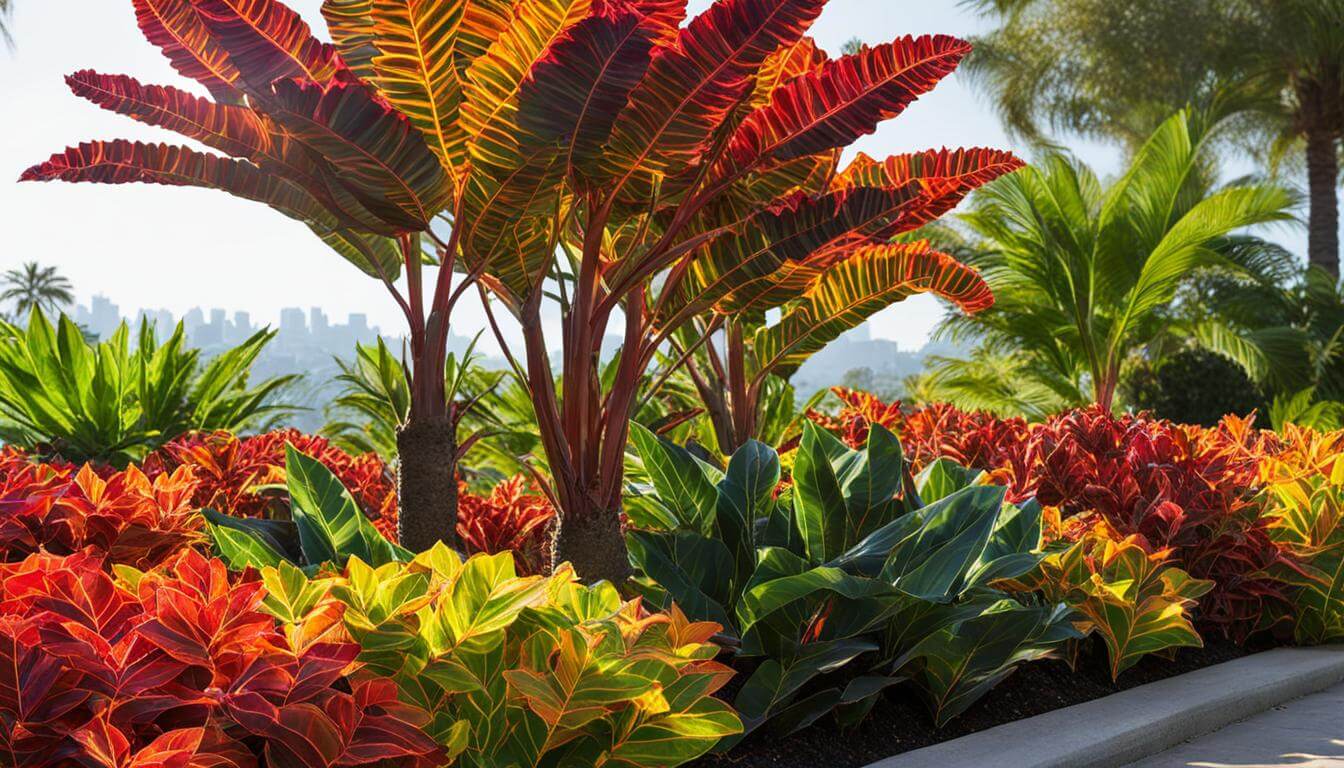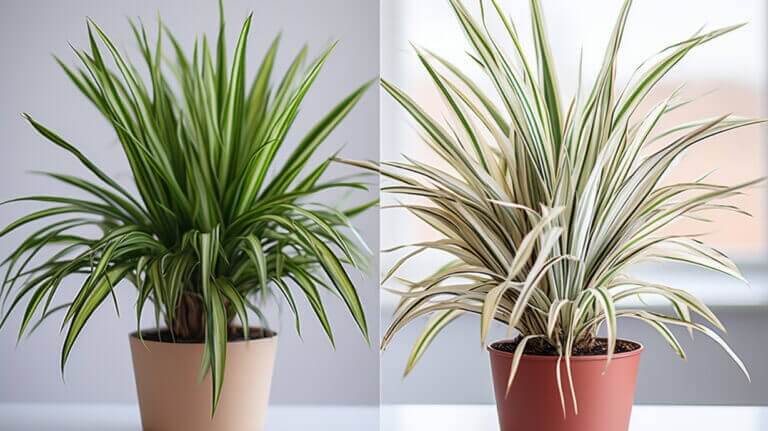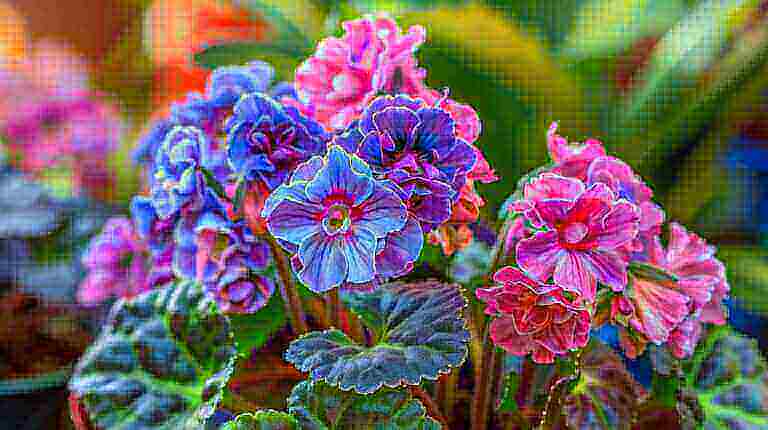Looking to add a burst of vibrant color to your garden or border? Consider landscaping with crotons. These tropical plants, known as codiaeum variegatum, are perfect for adding a touch of tropical flair to your outdoor space. With their colorful foliage in shades of red, orange, yellow, and even pink and purple, crotons create a stunning visual display.
Although crotons thrive in USDA zones 10 and 11, making them ideal for South Florida, they can also be grown in containers and brought indoors during the colder months. Whether you have a sprawling garden or a small balcony, crotons can be incorporated into your landscaping design.
Key Takeaways:
- Landscaping with crotons brings vibrant and colorful foliage to gardens and borders.
- Crotons are low maintenance and can tolerate drought conditions.
- They can be grown in various environments, including indoor pots and outdoor landscape beds.
- Crotons make excellent container plants, adding color and foliage to patios and balconies.
- They can be incorporated into garden designs, particularly in tropical-themed landscapes.
Benefits of Landscaping with Crotons
Landscaping with crotons offers a multitude of benefits, making them a popular choice for those looking to add a burst of color and vibrancy to their outdoor spaces. These colorful foliage plants are not only visually appealing but also require minimal maintenance, making them ideal for both novice and experienced gardeners.
Enhancing Curb Appeal
One of the key benefits of landscaping with crotons is the instant boost in curb appeal they provide. With their vibrant and eye-catching leaves, crotons can transform any garden or border into a focal point that attracts attention and admiration. Whether planted in clusters or incorporated into existing landscape designs, crotons add a touch of tropical flair that sets them apart from other plants.
Versatility in Landscaping Ideas
The versatility of crotons allows them to be seamlessly integrated into various landscaping ideas and designs. They can be used as standalone plants in containers, creating a vibrant display on patios, decks, or porches. Crotons also work well as borders or edging, providing a burst of color along garden pathways. Additionally, they can be grouped with other tropical plants to create a lush and exotic oasis.
Low Maintenance and Colorful Foliage
One of the standout features of crotons is their low maintenance requirements. These plants thrive in warm climates and can withstand drought conditions once established, reducing the need for frequent watering. Their colorful foliage remains vibrant throughout the year, making them an excellent choice for those seeking year-round visual interest in their gardens. Whether used as accents or focal points, crotons bring a splash of color that can elevate any landscape design.
Landscaping with crotons offers a range of benefits, from their vibrant and colorful foliage to their low maintenance requirements. Whether used as standalone plants, borders, or accents, crotons can enhance the curb appeal of any property and bring a touch of tropical flair to gardens and borders.
Growing Crotons in Different Environments
Crotons, also known as the codiaeum variegatum, are versatile plants that can thrive in various environments. Whether you want to grow them as indoor plants or use them as landscape shrubs outdoors, crotons can add vibrant colors and tropical flair to your surroundings.
When it comes to growing crotons indoors, they require bright but indirect light. Place them near a window where they can receive filtered sunlight throughout the day. Crotons prefer warm temperatures, so keep them away from drafts or cold areas. Make sure to water them regularly, but avoid over-watering as this can lead to root rot. With the right care and conditions, crotons can bring a touch of tropical beauty to your indoor space.
If you want to grow crotons outdoors as landscape shrubs, they can thrive in full sun or partial shade. These plants are relatively drought-tolerant once established, meaning they can withstand periods of dryness. However, it’s important to water them during prolonged dry spells to ensure their health and vitality. Crotons are perfect for adding a pop of color to your garden, whether you have a sunny area or a spot with some shade.
Table: Ideal Growing Conditions for Crotons
| Environment | Light | Temperature | Watering |
|---|---|---|---|
| Indoor plants | Bright but indirect light | Warm temperatures | Regular watering, avoiding over-watering |
| Outdoor landscape shrubs | Full sun or partial shade | Warm temperatures | Relatively drought-tolerant, but regular watering during dry spells |
As you can see, crotons can adapt to different growing conditions, making them suitable for a variety of environments. Whether you choose to grow them indoors or outdoors, these colorful plants will surely enhance the beauty of your space.
Crotons as Container Plants
Crotons are not only suitable for landscaping gardens and borders but also make excellent container plants. Their colorful leaves add vibrancy and visual interest to patios, porches, and balconies, creating a stunning display of foliage. When choosing crotons as container plants, it’s important to consider their care requirements to ensure their health and longevity.
To care for crotons in containers, they should be placed in an area that receives bright but indirect light. This can be achieved by positioning them near a window or providing them with filtered light outdoors. Crotons thrive in warm temperatures, so it’s essential to keep them in a location where the temperature remains above 60 degrees Fahrenheit.
Proper watering is crucial for container-grown crotons. The soil should be kept consistently moist but not waterlogged. It’s important to avoid overwatering, as it can lead to root rot. Regularly check the moisture level of the soil and adjust the watering frequency accordingly.
It’s worth noting that crotons are toxic to pets, so caution should be exercised when placing them in households with animals. Additionally, it’s advisable to fertilize container-grown crotons every two to three months during the growing season to provide them with the necessary nutrients for healthy foliage growth.
Table: Care Tips for Container-Grown Crotons
| Aspect | Care Tip |
|---|---|
| Light | Provide bright but indirect light |
| Temperature | Maintain a minimum temperature of 60 degrees Fahrenheit |
| Watering | Keep the soil consistently moist, but avoid overwatering |
| Pet Safety | Be cautious as crotons are toxic to pets |
| Fertilization | Apply fertilizer every two to three months during the growing season |
Using Crotons in Garden Design
Crotons offer a fantastic opportunity to add a pop of color and create visual interest in garden design. Whether you’re looking to enhance your garden beds or create a tropical oasis, crotons are an excellent choice. Their colorful leaves add vibrancy and beauty to any space, making them a standout feature in your garden.
Enhancing Garden Beds with Crotons
Crotons are a great addition to garden beds, as they complement other plants and flowers. Their colorful foliage stands out against greenery and adds a dynamic element to the overall design. You can use crotons to create striking borders or mix them in with other plants for an eye-catching display. Their evergreen nature ensures that your garden will remain vibrant and colorful throughout the year.
Creating a Tropical Garden with Crotons
If you’re aiming for a tropical garden, crotons are a must-have. Their bold, tropical foliage instantly adds an exotic flair to any landscape. Choose different varieties to create a diverse range of textures and colors. You can use crotons as focal points or plant them in groups to create a lush, tropical atmosphere. Pair them with other tropical plants and flowers to complete the look.
Adding Colorful Accents
Crotons also work well as standalone plants, providing colorful accents throughout your garden. You can strategically place them near entrances, patios, or other areas where you want to draw attention. Their vibrant leaves will immediately catch the eye and brighten up any corner of your garden. Consider combining different croton varieties to create a visually stunning display.
| Crotons in Garden Design | Benefits |
|---|---|
| Enhancing garden beds | – Complement other plants and flowers – Add vibrant colors |
| Creating a tropical garden | – Provide an exotic flair – Pair well with other tropical plants |
| Adding colorful accents | – Attract attention to specific areas – Brighten up corners or entrances |
Pruning and Maintenance Tips for Crotons
Pruning plays a crucial role in maintaining the health and appearance of crotons. By removing dead leaves and promoting bushier growth, pruning helps to keep these plants looking their best. Different croton varieties may require specific pruning techniques, so it’s important to familiarize yourself with the needs of your particular plant.
When pruning crotons, start by inspecting the plant for any dead or damaged leaves. Using sharp, clean pruning shears, carefully remove these leaves at their base. This will not only improve the overall appearance of the plant but also help prevent the spread of diseases or pests. Additionally, pruning off dead leaves allows the plant to focus its energy on producing new growth.
While crotons can benefit from occasional pruning, they are generally low-maintenance plants that do not require extensive maintenance. Regular watering and providing them with the proper growing conditions, such as bright but indirect light, will help keep them healthy and vibrant. With minimal effort, you can enjoy the stunning foliage and tropical flair that crotons bring to your garden or indoor space.
Croton Pruning Checklist:
- Inspect the plant for dead or damaged leaves
- Use sharp, clean pruning shears to remove dead leaves at the base
- Dispose of pruned leaves properly to prevent disease or pest spread
- Provide the proper growing conditions: bright but indirect light, moderate watering
- Monitor for signs of pests or diseases and take appropriate action
Following these pruning and maintenance tips will ensure that your crotons remain healthy and vibrant, enhancing the beauty of your landscape or indoor space with their colorful foliage.
Landscaping Ideas with Crotons
If you’re looking for landscaping ideas that will add a burst of color to your outdoor space, look no further than crotons. These vibrant plants with their colorful foliage can be used in various ways to create stunning landscapes. Whether you want to incorporate them in containers, as ground cover, or as hedges, crotons will add a tropical flair to your garden.
Container Plants
Crotons are excellent choices for container gardening. Placing them in containers allows you to easily move them around and experiment with different layouts. You can create eye-catching displays by combining crotons with other plants that complement their colorful leaves. Try using different varieties of crotons with varying heights and leaf shapes to add depth and interest to your container arrangements.
Ground Cover
If you’re looking to fill up empty spaces in your garden beds with colorful foliage, consider using crotons as ground cover. Their dense growth habit and vibrant leaves create a lush carpet of color. Choose a mix of croton varieties with different leaf shapes and colors to create a visually stunning ground cover. They will not only add visual interest but also suppress weed growth and retain moisture in the soil.
Hedges
Crotons can also be pruned and trained into beautiful hedges, providing both privacy and a striking visual element. Use crotons with dense foliage and compact growth habits for a well-defined and structured hedge. Regular pruning will help maintain the desired shape and encourage bushier growth. Incorporate croton hedges into your landscape design to create distinct areas and boundaries in your garden.
With these landscaping ideas, you can make the most of crotons’ colorful foliage and transform your outdoor space into a tropical paradise. Whether you choose to use them as container plants, ground cover, or hedges, crotons will bring vibrancy and visual interest to any garden.
Where to Find and Grow Crotons
When it comes to finding and growing croton plants, local garden centers or nurseries are excellent places to start your search. These establishments typically carry a variety of croton varieties, each offering unique colors and patterns to suit your preferences. Pay a visit to your nearest garden center and explore the wonderful world of crotons.
Growing croton plants requires an understanding of hardiness zones. Crotons are tropical plants that thrive in warm temperatures. Therefore, they are best suited for regions that fall within USDA hardiness zones 10 and 11. If you live in a colder climate, you may need to bring smaller croton varieties indoors during the winter months or consider them as container plants.
As a tropical plant, crotons bring an exotic touch to your garden or landscape. Their vibrant foliage adds a burst of color and creates a focal point in any setting. So, if you’re looking to embrace the tropical charm, consider adding these stunning plants to your collection.
FAQ
Can crotons be grown in colder regions?
Crotons are tropical plants and prefer warm temperatures, so they may not thrive in colder regions.
Can crotons be grown indoors?
Yes, crotons can be kept as indoor plants and add a touch of tropical beauty to the interior of a home.
Do crotons require a lot of maintenance?
No, crotons are low-maintenance plants that require minimal care and attention.
Are crotons toxic to pets?
Yes, crotons are toxic to pets, so caution should be exercised when placing them in households with animals.
Where can I find croton plants?
Croton plants can be found at local garden centers or nurseries.
What hardiness zones are suitable for growing crotons?
Crotons thrive in USDA zones 10 and 11, which are ideal for South Florida. However, smaller varieties can also be grown in containers and brought indoors during the winter months.
How do I care for croton plants in containers?
Crotons in containers should be provided with bright but indirect light. They should be placed in well-draining potting soil and watered regularly to keep the soil moist.
Can crotons be used as ground cover?
Yes, crotons can be used as ground cover, creating a carpet of colorful leaves.
Do crotons require pruning?
Pruning is an essential part of croton plant care to maintain shape and size, promote healthy growth, and prevent overcrowding.
What are some landscaping ideas that incorporate crotons?
Crotons can be used as colorful foliage plants in containers, as ground cover, or pruned and trained as hedges to provide privacy and add dimension to a landscape.







